|
Fujairah
The Emirate of Fujairah is frequently referred to as the bride
of the Emirates and the Gateway of the Gulf on the Eastern region.
In
virtue of the sagacious directives of H.H. Shaikh Hamad Bin Mohamed
Al Sharqi, member of the Supreme Council and Ruler of Fujairah,
the Emirate realized during the previous years  numerous
advances at various planes. All material resources were utilized to
boost the economy, expedite the strides of progress and create a healthy
climate for business activities. Following completion of the infrastructural
projects, the government of Fujairah worked out an ambitious plan to
achieve the ideal exploitation of its natural resources and expand commercial,
industrial and agricultural activities in all parts of the Emirate. numerous
advances at various planes. All material resources were utilized to
boost the economy, expedite the strides of progress and create a healthy
climate for business activities. Following completion of the infrastructural
projects, the government of Fujairah worked out an ambitious plan to
achieve the ideal exploitation of its natural resources and expand commercial,
industrial and agricultural activities in all parts of the Emirate.
Fujairah Photo Gallery
|
Geographical
Location, Area & Population:
|
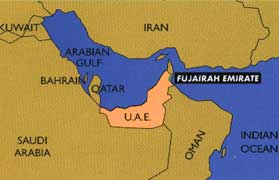
Unlike the other Emirates, Fujairah enjoys a unique position on the
Gulf of Oman, adjacent to the Strait of Hormuz, on the Eastern flank
of the Arabian Peninsula. Fujairah coasts extend 90 kms, along the Gulf
of Oman which accords a strategic importance to this Emirate. The area
of Fujairah is 1,165.5 kms, thus equivalent to 1.5% of the total area
of the UAE which puts it in the fifth position among the Emirates in
terms of size. The population of Fujairah totals 76,254 who live in
the various towns and villages which number 63. The most famous of these
towns and villages are Dibba, Merbah, Qidfa, Aqah, Faqeet and Bithna,
which are known for its relics and farms.
Climate: Climate of Fujairah is semi-arid with a wide diurnal range, limited
rainfall and humidity varying from month to month. The winter months
are mild.
Tourism is of great importance to Fujairah as the Emirate is renowned
for its scenic beauty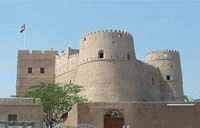 and other qualities, which make it a tourist attraction for those
seeking entertainment and tranquility. Fujairah is also renowned for
its high mountains of multiple colors and deep valleys where water courses
flow throughout the year which represent yet another attraction for
tourists. There are marine reserves where a variety of beautiful and rare sea creatures live amongst a jungle
of coral reefs another attraction for tourists interested in the diving
sport. Tourists are also attracted by the mineral and healing and other qualities, which make it a tourist attraction for those
seeking entertainment and tranquility. Fujairah is also renowned for
its high mountains of multiple colors and deep valleys where water courses
flow throughout the year which represent yet another attraction for
tourists. There are marine reserves where a variety of beautiful and rare sea creatures live amongst a jungle
of coral reefs another attraction for tourists interested in the diving
sport. Tourists are also attracted by the mineral and healing 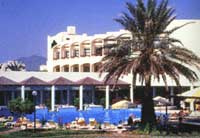 waters such as those to be found at the Madhab and Gamour springs. The waters of these springs are claimed by natives to heal from rheumatism and some skin diseases. The Wareea's waterfalls area is one of the most beautiful mountainous
spots in Fujairah. The ruins of old fortresses and mosques at Fujairah,
Bithna and Bidiya areas provide enormous clues to the spectacular history
of the region waters such as those to be found at the Madhab and Gamour springs. The waters of these springs are claimed by natives to heal from rheumatism and some skin diseases. The Wareea's waterfalls area is one of the most beautiful mountainous
spots in Fujairah. The ruins of old fortresses and mosques at Fujairah,
Bithna and Bidiya areas provide enormous clues to the spectacular history
of the region
In
accordance with the Emiri Decree No. 6 of 1987, the Fujairah Free Zone
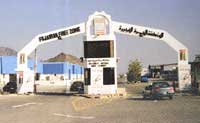 commenced
operation in November of the same year as an independent government
authority to promote
investment activities and provide benefits which will ensure success
of proposed projects as per the prevailing rules and regulations. In
1995 the capital invested in the Free Zone totaled Dhs.640 million.
The resident companies include 46 engaged in industrial activities in
such fields as readymade garments, textiles, cardboard, perfumes, chemicals,
animal fodder, steel dies, aluminium smeltering, medical bandages, colour
film slides, precious stones, food packing (meat, seafood etc.), tobacco
etc. commenced
operation in November of the same year as an independent government
authority to promote
investment activities and provide benefits which will ensure success
of proposed projects as per the prevailing rules and regulations. In
1995 the capital invested in the Free Zone totaled Dhs.640 million.
The resident companies include 46 engaged in industrial activities in
such fields as readymade garments, textiles, cardboard, perfumes, chemicals,
animal fodder, steel dies, aluminium smeltering, medical bandages, colour
film slides, precious stones, food packing (meat, seafood etc.), tobacco
etc.
There
are also commercial enterprises which deal in import, export and re-export
business. Most of the commercial enterprises facilitate marketing of
products manufactured within the Zone. The Free Zone covers an area
of 400,000 sq. metres and there are prebuilt areas of different sizes
for factory, warehouse and office rentals. An additional one kilometre
area has recently been developed to cater for new projects. The authorities
encourage setting up new industrial projects that employ high-tech machines
particularly in the foodstuff processing, mechanical and electrical
fields.
The
Port of Fujairah is one the best seaports in the Middle East and the
No. 3 in  the
Gulf in container handling. According to the latest statistics, the
port rated No.33 globally in container handling. The port lies outside
the Strait of Hormuz, overlooking the Arabian Sea which is famous for
its deep waters. The strategic position of the port, which is regarded
as the Eastern Gate of the UAE as well as its location midway between
the East and West, helped to attract many international shipping firms. the
Gulf in container handling. According to the latest statistics, the
port rated No.33 globally in container handling. The port lies outside
the Strait of Hormuz, overlooking the Arabian Sea which is famous for
its deep waters. The strategic position of the port, which is regarded
as the Eastern Gate of the UAE as well as its location midway between
the East and West, helped to attract many international shipping firms.
The
value of Fujairah foreign trade totalled Dhs.1.7 billion in1995, registering
an average annual rise of 30.2% according to statistics recently released
by Fujairah's Customs Department. Agriculture Fujairah is characterized
by the fertility of its soil and availability of potable water. Most
towns and villages are located in deep valleys in the bottom of high
mountains from which rain. There are also reservoirs of sub-soil water
and several dams set up in the valleys.
Agriculture
is widespread in Fujairah and its farms are known for their high produce.
But in addition to 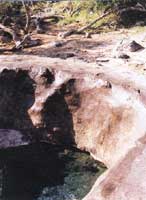 that
Fujairah is a coastal Emirate and it stretches for 90 kilometres along
the Eastern coast of the UAE which adds another quality to Fujairah
richness with variety of fish and seafood. Industry Industrialization
is accorded priority by the Fujairah government being an important option
for broadening the productive base and diversifying the sources of national
income, thereby to free the economy from dependence on oil as a sole
source of income. that
Fujairah is a coastal Emirate and it stretches for 90 kilometres along
the Eastern coast of the UAE which adds another quality to Fujairah
richness with variety of fish and seafood. Industry Industrialization
is accorded priority by the Fujairah government being an important option
for broadening the productive base and diversifying the sources of national
income, thereby to free the economy from dependence on oil as a sole
source of income.
The
Department of Industry and Economy is the focal point for industrialization
efforts in Fujairah. In co-ordination with the private sector, the Department
encourages setting up of an industrial base in various manufacturing
fields within the framework of the Emirate's overall development plan.
The Department also provides its services to new investors by preparation
of feasibility studies for projects. In addition to that the Department
supervises execution of major schemes which contribute to expediting
economic growth in Fujairah.
|

